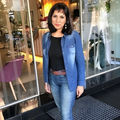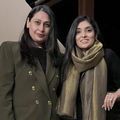Interviews
Smart/interactive clothing to be next area of growth
26 Oct '09
9 min read
According to BCC Research, the U.S. market for smart textiles was worth an estimated US $70.9 million in 2006. This figure is expected to reach $391.7 million in 2012, at a CAGR of 37.9% between 2007 and 2012. Sales of conductive fabric products are expected to more than double each year between 2007 and 2012.
Consumer products accounted for the bulk (98%) of U.S. smart textiles sales in 2006. However, the projected rapid growth of military, biomedical, and vehicle safety and comfort applications for smart textiles is expected to have a major impact on both the size and structure of the market.
Smart textiles are able to sense electrical, thermal, chemical, magnetic, or other stimuli from the environment and adapt or respond to them, using functionalities integrated into the textile structure. They do not have a fixed set of characteristics, but are an active element that works with its own control and response mechanism.
The U.S. military historically has been the leader in developing smart textile technologies and applications in such areas as body armor, artificial muscles, biochemical hazard protection, physiological status monitoring, location, and embedded communications and computing. Many of these same technologies also have potential civilian and commercial applications.
Indeed, the commercial sector has been ahead of the military in commercializing smart textile technologies. According to Venture Development Corporation (VDC), Interactive textiles or so-called smart fabric products will be reaching the market for healthcare/medical, public safety, military, and sporting applications later this year.
These products will be designed to monitor the wearer's physical well being and vital signs such as heart rate, temperature, and caloric consumption, among many others. VDC forecasts the fastest growth for interactive textiles demand in market segments such as healthcare/medical, consumer-sports and outdoor activities, and the military, among others.
Users in these markets are expected to embrace the true Wearability and comfort and bio-monitoring functionality provided by these products. The emergence of interactive textile or "smart fabric" products will also be driven by technological improvements and increasing reliance on MEMs based integrated sensors.
Development of flexible displays comprised of OLED or LEP technologies will be integrated into clothing solutions, providing the ability to view information in real-time via wireless communications. There are many companies (some of the leaders in this development include: Sensatex, DuPont, ADA, Foster-Miller, Santa Fe Science and Technology, SOFTswitch, and International Fashion Machines, among others) developing interactive textile products for usage in a wide range of applications.
The European market for smart fabrics and interactive textiles (SFIT) represented about €300 million in 2008 and is growingat a yearly rate of about 20%. As per the SFIT team, there are basically two kinds of smart clothes -
Consumer products accounted for the bulk (98%) of U.S. smart textiles sales in 2006. However, the projected rapid growth of military, biomedical, and vehicle safety and comfort applications for smart textiles is expected to have a major impact on both the size and structure of the market.
Smart textiles are able to sense electrical, thermal, chemical, magnetic, or other stimuli from the environment and adapt or respond to them, using functionalities integrated into the textile structure. They do not have a fixed set of characteristics, but are an active element that works with its own control and response mechanism.
The U.S. military historically has been the leader in developing smart textile technologies and applications in such areas as body armor, artificial muscles, biochemical hazard protection, physiological status monitoring, location, and embedded communications and computing. Many of these same technologies also have potential civilian and commercial applications.
Indeed, the commercial sector has been ahead of the military in commercializing smart textile technologies. According to Venture Development Corporation (VDC), Interactive textiles or so-called smart fabric products will be reaching the market for healthcare/medical, public safety, military, and sporting applications later this year.
These products will be designed to monitor the wearer's physical well being and vital signs such as heart rate, temperature, and caloric consumption, among many others. VDC forecasts the fastest growth for interactive textiles demand in market segments such as healthcare/medical, consumer-sports and outdoor activities, and the military, among others.
Users in these markets are expected to embrace the true Wearability and comfort and bio-monitoring functionality provided by these products. The emergence of interactive textile or "smart fabric" products will also be driven by technological improvements and increasing reliance on MEMs based integrated sensors.
Development of flexible displays comprised of OLED or LEP technologies will be integrated into clothing solutions, providing the ability to view information in real-time via wireless communications. There are many companies (some of the leaders in this development include: Sensatex, DuPont, ADA, Foster-Miller, Santa Fe Science and Technology, SOFTswitch, and International Fashion Machines, among others) developing interactive textile products for usage in a wide range of applications.
The European market for smart fabrics and interactive textiles (SFIT) represented about €300 million in 2008 and is growingat a yearly rate of about 20%. As per the SFIT team, there are basically two kinds of smart clothes -
Popular News
Leave your Comments
Editor’s Pick
Folker Stachetzki
Brother Internationale Industriemaschinen GmbH
Jason Kent
British Textile Machinery Association (BTMA)
































-Ltd..jpg?tr=w-120,h-60,c-at_max,cm-pad_resize,bg-ffffff)





.jpg?tr=w-120,h-60,c-at_max,cm-pad_resize,bg-ffffff)
.jpg?tr=w-120,h-60,c-at_max,cm-pad_resize,bg-ffffff)






